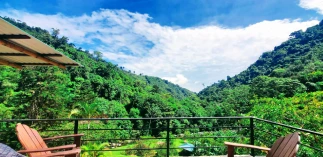Here at our Costa Rican mountain retreat, mornings begin with a symphony of birdsong. From the loud, melodic calls of the toucans to the delicate trills of the warblers, the soundtrack of the rainforest is a constant source of wonder. Today, we turn our attention to a smaller, shyer resident, the rufous-and-white wren.
A Flash of Rust and White
The rufous-and-white wren (Thryophilus rufalbus) is a true gem of the wren family. Measuring a mere 5.5-5.9 inches (14-15 cm) long, this compact songbird packs a punch in the personality department.
Its plumage is a beautiful combination of warm and cool tones. The upperparts are a rich chestnut brown, with a darker crown adding a touch of contrast. A striking white supercilium (eyebrow) brightens the face, which is further defined by a brown stripe through the eye and black streaks on the cheeks. The underparts are white, with black barring on the lower belly and flanks. The wings and tail echo the barring pattern, with black on brown.
Young rufous-and-white wrens lack the vibrancy of adults. Their upperparts are a duller brown, and their underparts are buff-tinged instead of pure white. The subspecies found in the Andean foothills of Venezuela, T. r. minlosi, has a unique touch – a greyish tinge on the crown and underparts.
A Voice in the Thicket
While the rufous-and-white wren is a visual treat, spotting one can be a challenge. These birds are quite shy and prefer the dense undergrowth of forests and scrublands. This makes them more likely to be heard than seen.
Their song is a haunting series of hollow, quavering hoots, starting and ending with one or more whistled notes. It’s a captivating melody that adds a touch of mystery to the forest.
Habitat and Habits
The rufous-and-white wren is a resident breeding bird in Central America, found from southwestern Mexico to northern Colombia and northwestern Venezuela. Here in Costa Rica, you’ll find them in the lowlands and foothills, from sea level up to an altitude of 1,500 meters (4,900 ft). They favor dry forests and, in wetter areas, more open scrubby woodlands. Interestingly, in Central America, they are mainly found on the Pacific side of the central mountain ranges.
These little insectivores spend their days foraging in the low vegetation, searching for insects, spiders, and other small arthropods to fuel their active lifestyles. They are adept at flitting through the undergrowth, their small size allowing them to navigate the dense foliage with ease.
Building a Home
The rufous-and-white wren is a resourceful builder. Their nest is a flask-shaped structure, constructed with twigs, leaves, and other plant material. They often place it 2–3 meters (6 ft 7 in – 9 ft 10 in) high in a tree or shrub, a safe haven for their future generations.
A Species of Least Concern
Thankfully, the rufous-and-white wren is classified as a species of Least Concern by the IUCN. However, habitat loss due to deforestation and degradation is always a threat to bird populations. Here at our mountain retreat, we are committed to sustainable practices that protect the rainforest ecosystem and the wonderful creatures that call it home.
Listen for the Song
While you might not see the rufous-and-white wren readily, keep your ears tuned for its haunting song. It’s a reminder of the hidden wonders that thrive in the lush forests of Costa Rica.
For more information, please view our comprehensive guide about the birds of Costa Rica







